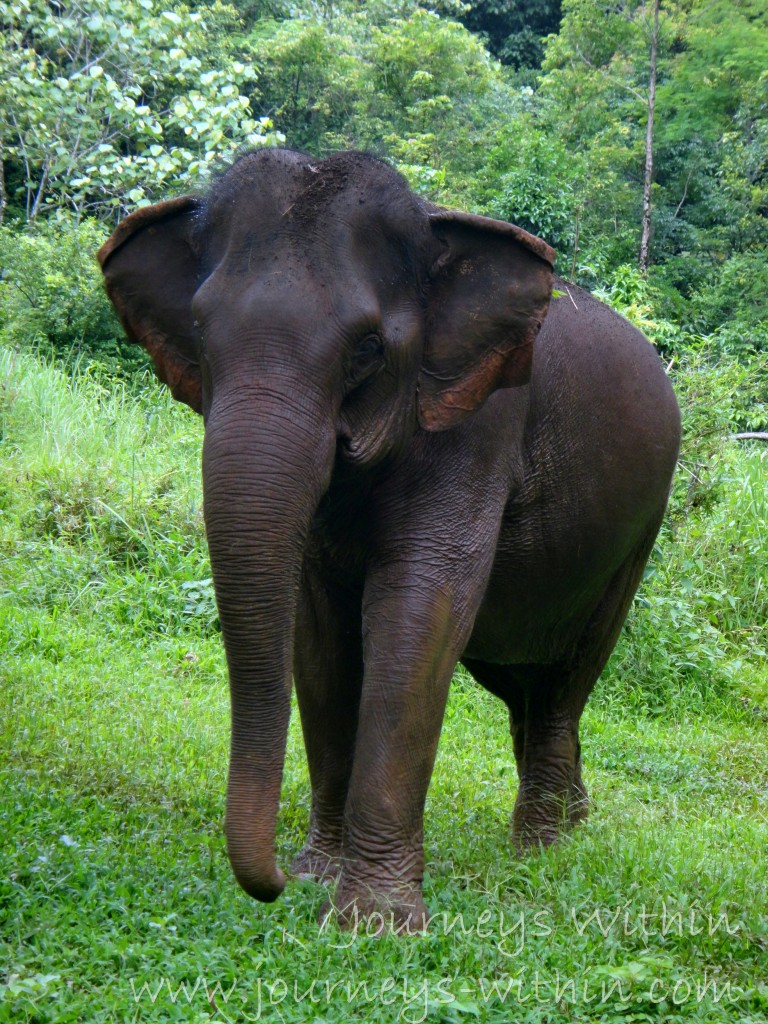One of the main reasons for our trip to the Northeast was to investigate sustainable wildlife opportunities for our guests …
Bob and Onion were the first elephants we laid our eyes on at the Elephant Valley Project. Giant, slow moving and deliberate a group of us watched as they made their way from the jungle into the river for a bath. The entire group was silenced by their presence, even the know–it-all freelance writer anxious to share his views on everything.
Conservation in Asia is a complicated equation. In a perfect world — which is of course an imaginary place — the intrinsic value of animals and ecosystems would always be respected and preserved. Realistically, as Cambodia and neighboring countries look to grow their economies, environmental interests are not alone and are often not prioritized.
While we were visiting the area, it occurred to me that Elephants, in all their glory, embody this modern-day struggle between development and conservation. As majestic as they are — to be in their presence is certainly overwhelming — their value in Asia goes well beyond an intrinsic one.
Currently, the biggest threat against the endangered wild Asian elephant is habitat loss and population fragmentation — there isn’t enough jungle left for them to roam and what is left separates herds with man-made obstacles.
For captive elephants and their owners in Mondulkiri there is an obvious struggle between traditions, economic opportunities and the animal’s welfare.
Looking to find a sustainable and humane elephant experience for our guests, my colleagues and I visited the Elephant Valley Project, a non-government organisation looking to improve the health and welfare of captive elephants.

After climbing down to the river, we watched silently as Onion submerge herself completely in the water, like a toddler down by the lake. Bob, less keen on dunking his head, was happy to blow water out of his trunk.
Recognizing that the well-being of the elephants in Mondulkiri depends on the well-being of the neighbouring communities, the Elephant Valley Project is taking a holistic approach to protection. Beyond providing a jungle sanctuary for the dozen or so elephants that are currently residents, the organization funds rangers to protect local parks, provides healthcare for the neighbouring village and offers training for mahouts looking to take better care of their elephants. Looking to alleviate poverty on a wider scale — the less desperate people are the better nature fares — the NGO is looking at extending their health coverage to include more villages.
While it remains to be seen how successful the Elephant Valley Project will be with their future outreach, there was something unique about the elephant experience they offer. They don’t allow riding, in fact interaction with the elephants is limited. What they do offer is an opportunity to see elephants in as natural an environment as could be created. The rescues create small herds, talk to each other and act like, well elephants. Having seen elephants throughout Asia, either chained up or walking in circles with a basket loaded with tourists, it was fascinating to see them in their element.
Elephant ownership is a tradition among the Bunong, the ethnic minority that inhabit the area around the sanctuary. Pachyderms have been caught and used throughout the region as work animals for generations. Once used for logging and construction, the aging animals are now being passed down to the next generation of owners whose knowledge of animal care and interest in the beasts is increasingly diluted; poverty-stricken children and grandchildren of original owners share the stake in what income the animal can produce.
While elephants are still being used for the odd logging job, there is increasing pressure on the animals to turn a profit, causing some families to look to the tourism industry as a money maker.
In Pulung village, we met a woman whose family was one of about twenty with shared ownership of a 55-year-old elephant. The elephant, once used in logging, was no longer needed in the forest and the families were struggling to care for the elephant on their meager income.
We were told the elephantsroam free until they are booked for a tour — one that includes walking the elephant to a local watering hole and giving it its daily bath. Upon having a tour booked, the elephant’s mahout would go into the jungle and collect the animal. Unlike the Elephant Valley Project, the Bunong do let guests ride the elephants for portions of the trek. Initially we were told that guests could only ride bareback, but later we saw evidence that baskets are still used. (Despite the size of the animal, it is not good for an elephant to carry heavy weight on its spine.)
While there was little doubt among my colleagues and I that the conditions weren’t ideal for the elephants, it was equally important for us to note that things weren’t much better for the community. Part of an ethnic minority, the Bunong have been relocated and forced to adapt to modern life. Living in small villages on the outskirts of Sen Monorom, they see little benefits from local tourism and even less investment in infrastructure from the government.
The community also seem to come to term with the fact that this would be the last generation to own elephants as the Bunong don’t breed their captive elephants. Baby elephants bred without the proper, very expensive, ceremony are believed to be bad luck and most of the captive elephants in the north are of an advanced age.
The pace and scale of development in Cambodia’s Northeast is having drastic effects of conservation efforts, not just for elephants. In Mondulkiri rubber plantations, road construction, mineral mining and logging are among the many interests vying for a piece of the same environmental pie. For the elephant’s sake, and ours, I sure hope there is enough to go around or that people learn to take less.



